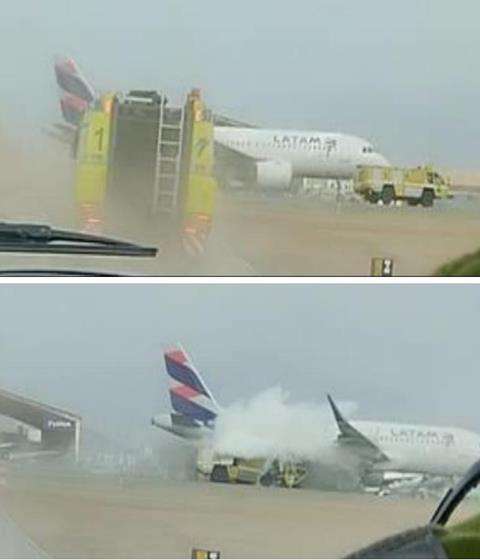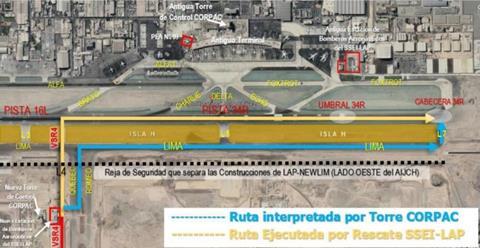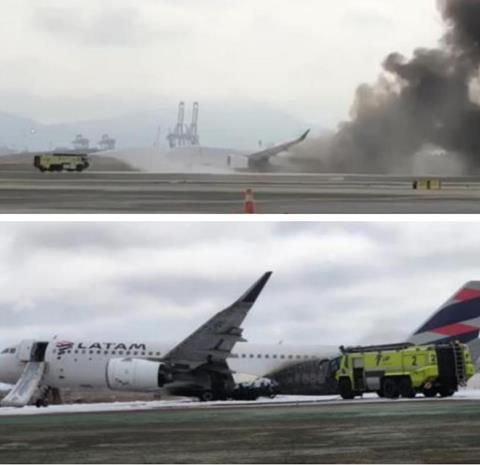Misunderstandings from poor planning and co-ordination of a rescue exercise preceded the fatal collision involving a departing LATAM Airbus A320neo and a firefighting vehicle which sped onto the runway at Lima.
Two of the three emergency personnel in the vehicle were killed after it entered runway 16L and was struck by the A320neo’s right-hand engine as the aircraft accelerated through 131kt.
The aircraft’s crew became aware of the approaching vehicle – which was travelling at 72km/h – just 3s before the impact.
Peruvian investigation authority CIAA indicates that any attempt by the crew to brake suddenly or take evasive action would have been “insufficient” given the high speeds and energy, and would probably have led to a “more serious” accident.

Lima airport had been undergoing expansion of its infrastructure including the introduction of a new parallel runway. This required the control tower and fire station to be relocated to a site between the runways.
Four emergency response-time exercises – using the old fire station, and the existing runway 16/34 – had taken place over the course of February-October 2022. None of these involved entering the runway; the vehicles drove along taxiways instead.
The second runway was due to become operational in early 2023 and exercises were being developed to test responses from the new fire station.
CIAA says the initial exercise was conducted on 17 August 2022. This involved emergency personnel driving from the new fire station along a vehicle service road called VSR4 which connected the station to the old runway, redesignated 16L/34R, and moving along the runway to the 34R threshold.
The response time recorded was 2min 48s.
Investigators state that a second exercise was planned for 18 November. While it was overseen by the same general supervisor from the August exercise, the rescue team supervisor tasked with co-ordinating a time-slot with the control tower had not taken part in the initial meeting at which the exercise was authorised.
CIAA says the rescue team supervisor called the control tower to establish a time-slot, but this communication was “limited and imprecise” because he was unclear about the general details of the exercise and the tower shift supervisor was left with an “erroneous interpretation” of how the exercise would proceed. No intervention took place from the general supervisor to clarify details or fill the gaps in information.
“This attitude reflected a marked overconfidence in prior planning,” says the inquiry.

The tower shift supervisor believed the rescue vehicles would travel from the new fire station, following taxiways Q, R and L until they reached the threshold of runway 34R, and that the drivers would request permission to enter the runway. This was the information given to the tower controllers.
CIAA says the general supervisor of the exercise told participating rescue personnel that the convoy – comprising two firefighting vehicles, R3 and R1, and a smaller observers’ truck, R7 – would travel along VSR4 to the runway and then continue to the threshold.
One of the firefighters of vehicle R1 told the inquiry that he perceived that authorisation to enter the runway was already “granted” and co-ordinated with the tower controllers, as it had been during the August exercise.
Crucially the tower controllers underwent a shift change at 15:00, just minutes before the exercise was due to begin, and no information about its scheduling was provided to incoming controllers.
The A320neo was cleared to the holding point of runway 16L just 2min after the shift change.
About 1min later the general supervisor sought authorisation from the ground controller to remove safety cones ahead of the rescue exercise. This opened access to the runway, but the ground controller – unaware of the exercise schedule – granted permission to the supervisor.
Just a few minutes before the exercise started, the tower shift supervisor informed controllers that a rescue convoy would be heading from the new fire station to a holding point on taxiway L, stressing the importance of keeping the convoy off the runway until the air traffic situation had been assessed.
The exercise commenced at 15:10, with the activation of the observer truck R7’s siren, and a notification over the ground radio frequency 121.9MHz. The general supervisor, travelling in R7, carried out all radio communication during the exercise.
No authorisation was sought from the tower controllers for runway access.
Forty seconds after the exercise began, the A320neo crew was cleared for take-off from 16L. CIAA says the pilots were “not aware” that the convoy had commenced a response exercise, much less that it would enter the runway.
The R3 firefighting vehicle, weighing 23t, led the convoy and was travelling at 72km/h – faster than R1 and R7, which were some 50-60m behind and averaging 64km/h.
CIAA says the driver of R3 had participated in the previous August exercise and might have accelerated to “improve his recorded time”. Vehicle R3 entered the runway from VSR4, and made a 45° turn to the right, in the direction of the 34R threshold.

The A320neo, bound for Juliaca, was 1,200m into its take-off roll when its right-hand engine struck the vehicle from behind, fatally injuring two of the firefighters and causing the A320neo’s engine to separate. The aircraft’s right-hand main landing-gear collapsed and a fire broke out as spilled fuel ignited.
Two firefighting vehicles, R2 and R4, responded to the crash alarm from the old fire station, while personnel from the R1 vehicle which had been taking part in the exercise also attended the aircraft, which came to rest next to taxiway G.
Nine of the 108 occupants of the A320neo suffered serious injuries. The third firefighter in the R3 vehicle was also seriously injured in the accident, and subsequently died in mid-June this year, seven months after the collision.
CIAA highlights several failings which contributed to the accident, including the absence risk analysis regarding exercises from the new fire station, poor co-ordination between the various parties over their detail and timing, and missed opportunities to address weaknesses in planning after the August exercise.




















